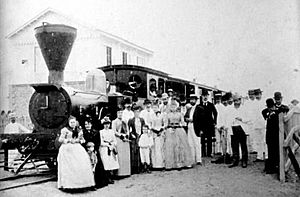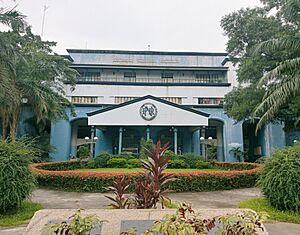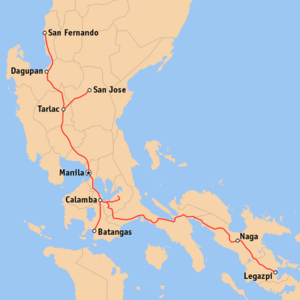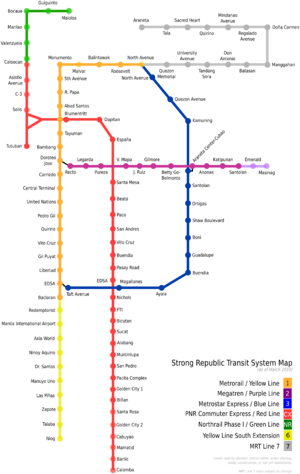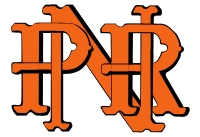Philippine National Railways facts for kids
 |
|
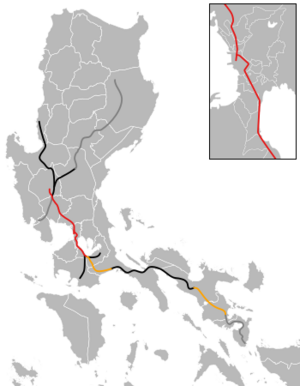
Network map, showing active lines (orange), inactive lines (black), historically proposed lines (gray) and the under-construction North South Commuter Railway (red).
|
|
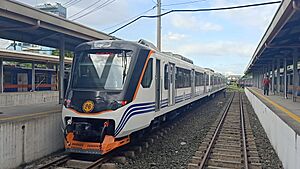
A PNR 8000 class at Tutuban station
|
|
| Overview | |
|---|---|
| Main region(s) | Metro Manila, Calabarzon, Bicol Region |
| Stations operated | 138 |
| Parent company | Government of the Philippines under the Department of Transportation |
| Headquarters | Tutuban, Tondo, Manila |
| Locale | Luzon |
| Dates of operation | June 20, 1964–present |
| Predecessors | Manila Railroad Company |
| Technical | |
| Track gauge |
|
| Electrification | 1,500 V DC overhead lines: North–South Commuter Railway (future) |
| Length | 133.09 km (82.70 mi) (active) |
| Operating speed | 20–40 km/h (12–25 mph) |
The Philippine National Railways (PNR) is a railway company owned by the Philippine government. It runs train services in parts of Luzon, including Laguna, Quezon, and the Bicol Region. PNR is part of the Department of Transportation.
PNR's story began way back in 1892 with the Ferrocarril de Manila-Dagupan, during the time the Philippines was under Spanish rule. Later, it became the Manila Railroad Company (MRR) when the Americans were in charge. PNR itself was officially created on June 20, 1964. It used to have over 1,100 km (684 mi) of railway lines, stretching from La Union all the way to the Bicol Region.
Over the years, the railway faced challenges like natural disasters and issues with people building homes too close to the tracks. These problems caused the train services to decline. However, the government is now working to improve and expand the railway system. They are bringing back old lines and building new ones.
Contents
History of Philippine Railways
Early Beginnings: Manila Railroad
The Philippine National Railways started with a company called the Manila Railway Company, Limited. This company got permission from the Spanish government in 1887 to build a train line from Manila to Dagupan. This line, called the Ferrocarril de Manila a Dagupan, opened on November 24, 1892. It later became the North Main Line. Train services to Southern Luzon, known as the South Main Line, were finished by 1937.
The Manila Railway changed its name to the Manila Railroad Company in 1906. In 1916, it became owned by the government. By 1939, the MRR had 1,140 kilometers (710 mi) of tracks across Luzon. Sadly, many of its tracks and trains were destroyed during World War II. Most of the railways were rebuilt by the 1950s. The MRR then started changing from steam-powered trains to diesel trains. Regular steam train services ended in 1963. Soon after, the Manila Railroad became the Philippine National Railways.
PNR's Creation and Challenges
The Philippine National Railways was officially created in 1964. This happened during the time Diosdado Macapagal was president. PNR's website says that the company was at its best in the 1960s and early 1970s. During this time, many thousands of people rode its trains every day. It had a large network of commuter trains in and around Metro Manila.
Later, PNR faced many problems that caused it to decline. These included natural disasters and not enough support from the government. In the 1970s, government money was used more for roads and highways instead of railways. In 1979, President Ferdinand Marcos made PNR part of the Ministry of Transportation and Communications. This ministry is now the Department of Transportation (DOTr). However, PNR still lost a lot of money. By 1983, not enough funding led to fewer services and about 1,000 employees losing their jobs.
The railway's decline became clear as parts of the North Main Line closed. In 1984, services stopped at Paniqui, Tarlac, because a bridge collapsed. Services were cut even shorter to Caloocan in 1988. However, commuter services briefly went to Malolos starting in 1990. This was part of the Metrotren project, but it closed in 1997.
Modern History and Revival Efforts
Rebuilding the Railways
The government, under President Gloria Macapagal Arroyo, worked hard to rebuild the Philippine National Railways. They invested in many projects to bring back train transport in the Philippines. These efforts included three main projects: Northrail, Southrail, and the Northrail–Southrail Linkage. The Northrail project aimed to fix the North Main Line from Caloocan to San Fernando, La Union. It planned to upgrade the single track to a raised double-track system. It also aimed to change the rail gauge from narrow gauge to standard gauge. This project would connect Manila to Malolos in Bulacan and then to Angeles City, Clark Special Economic Zone, and Clark International Airport.
The Southrail project planned to fix the entire South Main Line. This line runs from Calamba to Lucena, and then to Legazpi, Albay. It also included a new extension to Matnog. The linkage project aimed to connect the North and South lines.
In 2003, the Northrail project was given to a Chinese company for $421 million. It was expected to cost around US$500 million, with China offering to help pay for it. Construction started in 2006. However, the project faced problems and delays, and its cost grew to US$2 billion.
In 2009, President Arroyo launched new diesel trains. PNR also changed its brand name to PNR Filtrack, but this was later changed back. While the Southrail plans were not fully completed, the first part of the linkage project from Caloocan to Alabang was finished in 2010. This included rebuilding bridges and tracks.
The Northrail project was finally canceled in 2011 by President Benigno Aquino III due to legal issues. Still, railway repairs continued. The Bicol Express train service started again on June 29, 2011, with trips between Manila and Naga, Camarines Sur. However, after a train accident, the Bicol Express service was stopped indefinitely on October 26, 2012. Only the Metro Commuter Line kept running.
Recent Developments
By 2015, the Northrail project was replaced by a new plan called the North–South Railway Project (NSRP). This project aimed to improve PNR. It had two parts: NSRP North and South. The North line's first part is the North–South Commuter Railway (NSCR). This is a 37-kilometer (23-mile), electric narrow gauge commuter railway from Tutuban to Malolos. The second part involved rebuilding the long-distance services to La Union. The South line included fixing the Metro Commuter line from Tutuban to Calamba. It also planned to rebuild the South Main Line with an extension to Matnog, Sorsogon.
These plans were changed by President Rodrigo Duterte's government. The NSCR was extended to New Clark City. It also included rebuilding the Metro Commuter line. The long-distance part of the South line became the South Long Haul project. This project would rebuild the South Main Line. All new railway lines were planned to use standard gauge, which is different from the narrow gauge PNR currently uses.
After almost 20 years, PNR reopened the Metro North Commuter line on August 1, 2018. They also started the Caloocan–Dela Rosa shuttle line. This led to more train services in the north, reaching Malabon. Plans were also made to reactivate the Carmona line and bring back cargo trains from Port Area, Manila, to Laguna.
PNR became a provisional member of the International Union of Railways in November 2018. In June 2019, PNR received ISO 9001 certification for its railway repair, maintenance, and station operations.
On February 16, 2023, the Department of Transportation announced that PNR train operations would temporarily stop for five years. This was to allow for the construction of the NSCR. The Alabang–Calamba section closed on July 2, 2023, and the Tutuban–Alabang section closed on March 28, 2024. New public transport routes were created to help people during this closure. Train services in the Bicol Region were expanded on December 23, 2023.
Train Operations and Services
PNR currently runs trains in Laguna, Quezon province, and the Bicol region. In the late 1980s, PNR had regular long-distance services. These ran from Tutuban to San Fernando, La Union on the North Main Line and Legazpi, Albay on the South Main Line. There were also smaller lines going to Batangas, Cavite, Nueva Ecija, Rizal, and Tarlac.
As of March 27, 2024, PNR stopped its operations in Metro Manila. This includes the Gov. Pascual to Bicutan and Tutuban to Alabang sections. This temporary stop will last for at least five years. It is to make way for the construction of the North–South Commuter Railway (NSCR). The NSCR will use the same route but will be elevated and use electricity. The old tracks will be fixed for future freight services and connections to other lines.
PNR usually operates almost every day. However, services are stopped during Holy Week for yearly maintenance. This is because fewer people travel then. Normal operations start again on Easter Sunday.
Types of Train Services
| Service | Terminus | Status | |
|---|---|---|---|
| Metro South Commuter (MSC) | Tutuban | Alabang | Suspended |
| Tutuban | Mamatid | Discontinued | |
| Tutuban | Calamba | Suspended | |
| Tutuban | IRRI (UP Los Baños) | Suspended | |
| Tutuban | San Pedro | Suspended | |
| Metro North Commuter (MNC) | Tutuban | Governor Pascual | Suspended |
| Tutuban | Valenzuela | Planned | |
| Inter-Provincial Commuter | San Pablo | Lucena | Operational |
| Calamba | Lucena | Operational | |
| Calamba | San Pablo | Operational | |
| Shuttle Service (SS) | Governor Pascual | Bicutan | Suspended |
| Valenzuela | Bicutan | Planned | |
| Dela Rosa | Carmona | Planned | |
| Tutuban | Sucat | Discontinued | |
| Santa Mesa | Sucat | Discontinued | |
| Alabang | Calamba | Planned | |
| Premiere Train | Tutuban | Mamatid | Discontinued |
| Bicol Commuter Train (BCT) | Tagkawayan | Naga | Suspended |
| Sipocot | Naga | Operational | |
| Naga | Legazpi | Operational | |
| Bicol Express (BEx) | Tutuban | Naga | Suspended |
| Tutuban | Ligao | Suspended | |
| Mayon Limited Deluxe (MLD) | Tutuban | Ligao | Discontinued; replaced by ILE |
| Mayon Limited Ordinary (MLO) | Tutuban | Ligao | Discontinued; replaced by ILE |
| Isarog Limited Express (ILE) | Tutuban | Naga | Suspended |
Metro Commuter Line
The Metro Commuter line is PNR's main service in the Manila metropolitan area. It used to go as far south as Calamba and Los Baños in Laguna. PNR uses different types of trains for this service, including Hyundai Rotem DMUs, 8000 class DMUs, and 8100 class DMUs.
The Metro North Commuter line was reactivated and ran from Caloocan to Makati. It later extended to FTI in Taguig. A shuttle service also ran between Caloocan and Tutuban. The line was extended to Governor Pascual in Malabon in December 2018. Another extension to Valenzuela City was planned in August 2019.
These lines are temporary because of the NSCR construction. The reconstructed lines will be used for freight trains and future extensions to the north.
Shuttle Service
The Shuttle Service started on January 27, 2014. It used Hyundai Rotem DMUs and JR KiHa 52 trains. There were two routes: Tutuban – Sucat and Santa Mesa – Sucat. This service stopped on May 23, 2014, for train maintenance.
In 2018, a new shuttle line started from 10th Avenue to Dela Rosa. This was part of fixing the line and bringing back train services to Caloocan. This service was extended to Sangandaan and then to FTI. In December 2018, it extended north to Governor Pascual in Malabon. In December 2019, it extended south to Bicutan.
Bicol Commuter
The Bicol Commuter service runs in the Bicol Region. It connects stations in Tagkawayan, Quezon, and Legazpi, Albay. Naga acts as a main station. It has three services: Tagkawayan-Naga (suspended), Sipocot-Naga (operational), and Naga-Legazpi (operational).
This service first launched on September 16, 2009. After some changes, only the service between Sipocot and Naga was running by December 2013. Service between Naga and Legazpi started again on September 18, 2015. However, services were cut again in April 2017 due to not enough trains and typhoon damage.
Plans to restore the full route from Sipocot, Naga, and Legazpi were made in September 2019. The Naga-Sipocot part of the Bicol Commuter service was restored in 2022. On July 31, 2022, PNR started operations again between Ligao and Naga. The Naga–Legazpi route reopened on December 27, 2023.
As of 2024, the Naga-Legazpi Route uses 8300 class coaches pulled by an INKA CC300 locomotive. The 8000 class DMU is used on the Naga - Sipocot Line.
Past Services
Intercity Services
PNR's long-distance train services on its two main lines, the North Main Line and South Main Line, have been stopped since 2014.
The South Main Line was the main long-distance service after the North line closed in 1991. However, PNR also stopped its regular long-distance services in 2006. This was due to natural disasters and poor track conditions. The Bicol Express ran sometimes between 2009 and 2014.
There are plans to bring back both lines. The North Main Line area is now being used to build the elevated part of the North–South Commuter Railway. The South Main Line is planned to be rebuilt and extended to Matnog, Sorsogon. The smaller line to Batangas City will also be rebuilt. Test runs along the South Main Line happened in September 2019.
North Main Line Services
The North Main Line first opened in 1892. At its best, between the 1950s and 1960s, the line had full double-track railways from Tutuban to Dagupan. It also went to San Fernando, La Union. It had smaller lines to different areas in Central Luzon. However, its services got much worse in the 1980s. All regular operations outside Metro Manila ended in 1988.
South Main Line Services
Long-distance services on the South Main Line ran between Manila and Legazpi from 1916 to 2014. This included the Bicol Express and Mayon/Isarog Limited services. These services were very popular in the 1960s.
Non-Passenger Services
Freight services used to be a very important part of PNR's operations. Freight services stopped in 2003. Since then, there have been ideas to bring back freight services as part of PNR's Long Haul projects.
The Manila Railroad also owned the Manila Hotel for some time. They also had "hospital trains" in the 1930s. These were trains converted into hospitals.
Train Stations
The Philippine National Railways uses two main lines: the North Main Line and the South Main Line. It also has three smaller lines. These lines served different parts of Luzon with 138 active stations at one point.
Station Design
All PNR stations were and are currently at ground level. Most stations have a side platform design. They usually have basic facilities like platforms and ticket booths. Stations that have been fixed up along the Metro Manila line now have ramps for passengers using wheelchairs. Some stations have longer platforms. These have an upper platform for modern trains and a lower platform for older, locomotive-pulled trains. As of August 2017, most stations were being improved with longer roofs, better ticket offices, and restrooms.
Future railway systems under PNR, like the North–South Commuter Railway line, will have elevated, ground-level, and underground stations. These will be similar to the Manila LRT and MRT stations.
Modernization and Future Plans
The PNR system has been neglected for many years. Because of this, several plans to fix and expand the network have been suggested by different governments. Countries like South Korea, China, Japan, and Indonesia have helped with these plans. Most of these plans are about fixing and modernizing the main lines in Luzon. The government plans a complete overhaul of the PNR system. This includes making it electric and changing from narrow gauge to standard gauge. They also plan to change from single to double track. The standard gauge system is expected to have a total track length of about 4,000 km (2,500 mi).
City Train Systems
North–South Commuter Railway
The North–South Commuter Railway (NSCR) is the newest project to improve both the old North and South Main Lines. This is especially true for the parts in the Greater Manila Area. This project was first planned in the 1990s. It faced problems with money and disagreements. It finally started to take shape in November 2017. The NSCR will be a 36-station, 147 km (91 mi) elevated railway system. It will run from New Clark City in Capas, Tarlac to Calamba, Laguna. It will be the first electric main line in the country. Construction on the railway began in 2019. Once it is fully finished, it will carry at least 300,000 passengers. While the elevated line will use electric trains, the old lines below will be used for freight trains or existing commuter trains.
MRT Line 8
As part of President Rodrigo Duterte's infrastructure program, a project called East-West Rail was suggested. This project involves building and maintaining a mostly elevated rapid transit line. It would run from Diliman in Quezon City to Quiapo in Manila. In 2018, PNR said it would help build and operate this line. The line will have 11 stations and be 9.4 kilometers (5.8 mi) long. Most of it will be elevated. The project is currently waiting for approval.
Long-Distance Train Systems
PNR South Long Haul
The South Long Haul project, also known as PNR Bicol, plans to rebuild the long-distance line between Metro Manila and the Bicol Region. This project now involves a complete overhaul of the railway. It will change the railway to standard-gauge, replacing the old line. The line will first be built as a single-track system. However, there are plans to upgrade it to double-track or make it electric in the future. Stations will have passing sidings so that express trains can travel without stopping.
Mindanao Railway
President Rodrigo Duterte supported building a railway system across the entire island of Mindanao. This railway system will have about 2,000 kilometers of track. It is considered one of Rodrigo Duterte's main infrastructure projects. The first part, which is 105 kilometers (65 mi), started construction in 2018.
Bringing Back Freight Services
In 2016, PNR became interested in bringing back its freight services. There were plans to work with a rail freight company called MRAIL. This would involve fixing the rail lines to North Harbor and restarting freight services. This would also help reduce traffic jams and truck use in Metro Manila. If completed, MRail would operate the freight service with PNR. This would end a long time without railway freight services in the country.
As of 2021, the plans to bring back freight services were not yet in effect. This was likely due to the COVID-19 pandemic.
Train Fleet
PNR has used many types of locomotives, carriages, and multiple units. As of 2019, the trains mostly run on diesel. The DOST Hybrid Electric Train can also run on electricity, even though it starts with a diesel engine. All current trains use a 1067 mm|lk=on track width. PNR also has cranes on rails to help with maintenance.
In late 2019, the trains were improved. Some trains received a new blue-orange paint job. One type of locomotive was fixed up and repainted. PNR also added more trips to its service.
Train Colors and Designs
The Manila-Dagupan Railway, the Manila Railroad Company, and the Philippine National Railways have used different colors and designs on their trains over the years. These often celebrated the arrival of new trains.
Steam Train Era (1892–1954)
There are no colored pictures of the early trains. However, based on old locomotives, the steam trains were mostly black.
Early Diesel Train Colors (1948)
The first diesel trains were black or white, and orange. The old carriages that were fixed up in the late 1940s also used these colors.
MRR/PNR Colors (1955)
When the first diesel trains arrived, the MRR changed its colors to dark green and yellow, or yellow-orange and dark green. These colors stayed when the government took over and renamed it PNR. By the 1980s, the diesel trains were yellow with dark green wing-like symbols.
Commuter Train Colors (around 1978)
In the late 1970s, the commuter trains used in Metro Manila and the Bicol Region were white and navy blue.
Metrotren Colors (1990)
When President Corazon Aquino launched the "Metrotren" service in 1990, the trains were repainted navy blue, white, and red. This was used until the mid-2000s.
Philippines 2000 Colors (1997)
Some locomotives had a red color to celebrate President Fidel V. Ramos' Philippines 2000 program. Some freight carriages also had "Philippines 2000" painted on them.
A navy blue color scheme was introduced after the Philippines 2000 program ended. This happened after PNR got new coaches from Japan. The commuter trains were navy blue with orange highlights. The locomotives also changed to navy blue and orange. This color scheme was brought back in 2011.
Filtrack Colors (2009)
PNR tried to improve the Bicol Express in 2009. This included a new logo and train colors. The trains used white and orange. The trains also had the "Filtrack" brand on them. However, this did not last long. By 2015, all trains went back to the navy blue color scheme from the 2000s.
INKA Colors (2019)
PNR announced another logo and color change in 2019. This happened after the Duterte administration announced major changes to PNR. The PNR logo now looks like a seal. Its colors changed from orange and blue to golden yellow and blue. At the same time, the trains also changed their colors with the arrival of new trains from Indonesia. The colors varied, but the common theme was orange (as the main highlight), white (as the main body color), navy blue (as a side line), and black (as the bottom color).
NSCR Electric Train Colors (2021)
For the North–South Commuter Railway, the Department of Transportation ordered 104 train cars from Japan in July 2019. The first design showed a bluish-purple color.
However, the design changed when PNR showed a model of the front of the PNR EM10000 class trains in June 2021. The trains now have a red-orange color and eagle designs on the sides.
See also
- Department of Transportation
- List of Philippine National Railways stations
- Panay Railways
- Rail transportation in the Philippines
- Strong Republic Transit System


